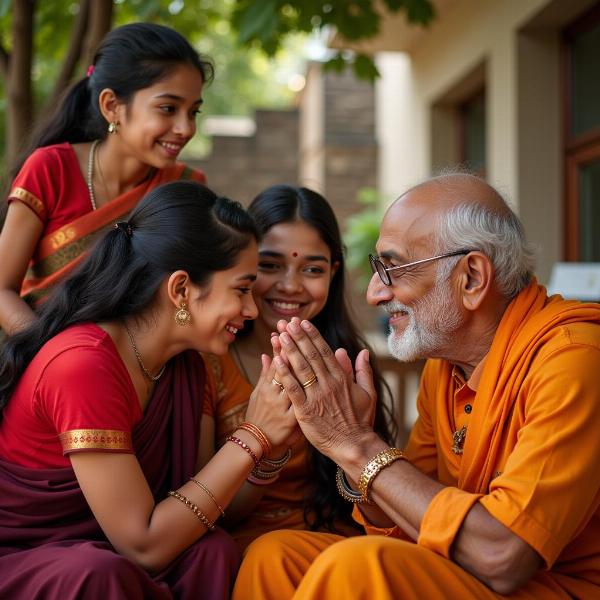Understanding the true meaning of “grazie” and its equivalent in Hindi goes beyond simple translation. It delves into the cultural nuances of expressing gratitude in both Italian and Indian contexts. While “grazie” beautifully encapsulates thankfulness in Italian, conveying the same sentiment in Hindi offers a rich tapestry of expressions, reflecting the depth and diversity of Indian culture. This article explores various ways to say “thank you” in Hindi, examining formal and informal expressions, regional variations, and the cultural context surrounding gratitude in India.
Exploring the Hindi Equivalents of “Grazie”
The most common and versatile equivalent of “grazie” in Hindi is “धन्यवाद” (dhanyavaad). This word is widely understood and accepted across India and is suitable for most situations. However, the beauty of Hindi lies in its diverse vocabulary, offering a plethora of ways to express gratitude with varying degrees of formality and emotional depth.
-
शुक्रिया (shukriya): This is a more informal and commonly used term, similar to “thanks” in English. It’s perfect for everyday interactions and conveys a warm sense of appreciation.
-
मेहरबानी (meherbaani): This term carries a deeper sense of gratitude and obligation. It implies a significant favor or kindness received and is often used in more formal settings.
-
आभार (aabhaar): Similar to “meherbaani,” “aabhaar” expresses profound gratitude and respect. It is often used in written communication or formal speeches.
Regional Variations in Expressing Gratitude
Just as dialects vary across Italy, India’s linguistic landscape is rich with regional variations. While “dhanyavaad” and “shukriya” are universally understood, certain regions have their own unique ways of saying “thank you.” For instance, in some parts of North India, you might hear “आपका बहुत-बहुत धन्यवाद” (aapkaa bahut-bahut dhanyavaad), which adds emphasis to the expression of gratitude. Similarly, South Indian languages have their distinct terms, further enriching the spectrum of expressing thankfulness.
Cultural Context of Gratitude in India
Gratitude is deeply ingrained in Indian culture. It’s not merely a polite gesture but a way of life, reflecting the values of respect, humility, and acknowledging the interconnectedness of all beings. From expressing thanks for a simple act of kindness to showing reverence for elders and teachers, gratitude permeates every aspect of Indian society. This cultural emphasis is often manifested in gestures like joining hands (Namaste) and offering gifts as tokens of appreciation.
 Indian Culture and Gratitude
Indian Culture and Gratitude
How do you say “thank you very much” in Hindi?
You can say “aapkaa bahut-bahut dhanyavaad” (आपका बहुत-बहुत धन्यवाद) or “bahut shukriya” (बहुत शुक्रिया) for “thank you very much” in Hindi.
What is the most formal way to say thank you in Hindi?
“Aabhaar” (आभार) is considered one of the most formal ways to express gratitude in Hindi.
Beyond Words: Expressing Gratitude Through Actions
While verbal expressions of gratitude are essential, actions often speak louder than words. In India, offering a small gift, helping someone in need, or simply showing respect and kindness are all powerful ways of expressing gratitude. This emphasis on action reflects the belief that true gratitude goes beyond mere words and manifests in tangible expressions of appreciation.
Conclusion: More Than Just “Grazie”
Understanding the meaning of “grazie” in Hindi opens a window into the rich cultural tapestry of India. From the formal “dhanyavaad” to the informal “shukriya” and the regionally diverse expressions, the language offers a nuanced and multifaceted way of expressing gratitude. By exploring these linguistic and cultural nuances, we gain a deeper appreciation for the importance of gratitude in human interactions and the diverse ways it is expressed across cultures. Remember, expressing gratitude is more than just saying “thank you;” it’s about acknowledging kindness, fostering connection, and enriching our relationships.
FAQ:
-
What is the simplest way to say “thank you” in Hindi? Shukriya is the easiest and most common way.
-
Is “dhanyavaad” formal or informal? Dhanyavaad is suitable for both formal and informal situations.
-
How do I express deep gratitude in Hindi? Aabhaar or Meherbaani are appropriate for expressing deep gratitude.
-
Are there regional differences in expressing thanks in India? Yes, there are regional variations, although dhanyavaad and shukriya are universally understood.
-
Besides words, how else can I express gratitude in India? Gestures like joining hands (Namaste), offering gifts, and acts of service are common ways to show gratitude.
-
What is the cultural significance of gratitude in India? Gratitude is deeply embedded in Indian culture, reflecting values of respect, humility, and interconnectedness.
-
Is there a difference between “shukriya” and “dhanyavaad”? Shukriya is generally more informal than dhanyavaad.
Meaning-Hindi.in is your premier destination for professional Hindi translation services. We specialize in various translation needs, from business and legal documents to technical manuals and website localization. Our expert team ensures accurate and culturally sensitive translations, bridging the language gap for businesses and individuals alike. Need help translating “grazie” or any other term into Hindi? Contact us at [email protected] or call us at +91 11-4502-7584. Meaning-Hindi.in is committed to delivering high-quality language solutions tailored to your specific requirements.